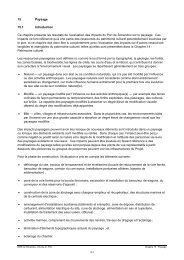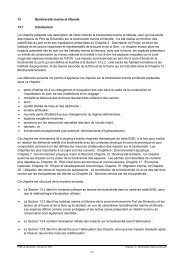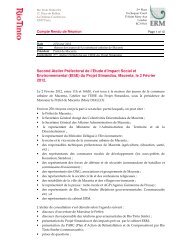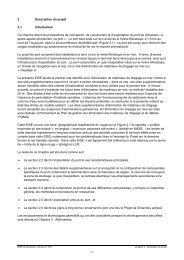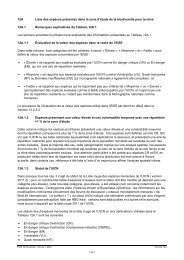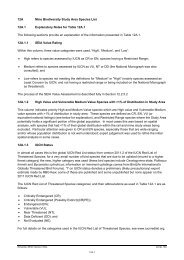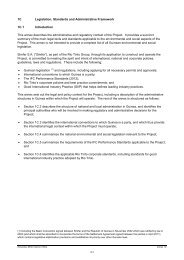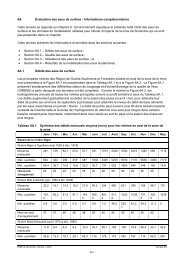Annex 14C: Cultural Context for West Africa and Guinea - Rio Tinto ...
Annex 14C: Cultural Context for West Africa and Guinea - Rio Tinto ...
Annex 14C: Cultural Context for West Africa and Guinea - Rio Tinto ...
You also want an ePaper? Increase the reach of your titles
YUMPU automatically turns print PDFs into web optimized ePapers that Google loves.
<strong>14C</strong>.2 Detailed <strong>Cultural</strong> Chronology (1)<br />
The following overview of cultural history <strong>and</strong> prehistory in <strong>West</strong> <strong>Africa</strong> was developed from st<strong>and</strong>ard<br />
published sources as part of the desk study <strong>for</strong> the cultural heritage assessment. It provides a context <strong>for</strong><br />
underst<strong>and</strong>ing <strong>and</strong> evaluating archaeological sites present in the study area. Archaeological sites <strong>and</strong><br />
historic monuments of the described prehistoric <strong>and</strong> historic periods are the tangible record of human<br />
developments <strong>and</strong> as such have both universal scientific <strong>and</strong> cultural value. <strong>Cultural</strong> Heritage sites are also<br />
sometimes associated with intangible aspects of <strong>Guinea</strong>’s traditional cultures <strong>and</strong> thus may hold deep<br />
significance to the local people.<br />
The following cultural chronology is divided into two broad periods: Prehistoric (200 000 BC – AD 1000) <strong>and</strong><br />
Historic (AD 1000 – Present). This division reflects the significant changes that occurred around AD 1000<br />
with the rise of the Ghana Empire (sub-Saharan <strong>Africa</strong>’s first empire), the influence of Islam, the appearance<br />
of detailed historical texts, <strong>and</strong> the general inclusion of <strong>West</strong> <strong>Africa</strong> into the global arena through European<br />
<strong>and</strong> Mediterranean trade networks.<br />
<strong>14C</strong>.2.1 Prehistoric Periods: 200 000 BC – AD 1 000<br />
<strong>14C</strong>.2.1.1 Early Stone Age (ESA): 200 000 – 100 000 BC<br />
This is the time period of the expansion of Homo erectus out of South <strong>and</strong> East <strong>Africa</strong> to other points on the<br />
globe, including <strong>West</strong> <strong>Africa</strong>. Remains from early Homo erectus are composed purely of stone tool<br />
technologies. Acheulian stone tools, which become wide-spread during the ESA, are found in fairly high<br />
densities in the western Sahara <strong>and</strong> are found in small numbers across <strong>West</strong> <strong>Africa</strong>. Plant <strong>and</strong> animal<br />
remains from these sites suggest a grassl<strong>and</strong> / scattered woodl<strong>and</strong> habitat (2) . Sites such as El Beyyed in<br />
Mauritania, with thous<strong>and</strong>s of stone bi-face tools, indicate that favourable Saharan climates may have<br />
supported stable populations over a long period of time.<br />
Oldowan lithics have been identified at a scatter of sites from the present <strong>for</strong>est region in Nigeria to the<br />
Sahara. At Yapei in Northern Ghana a number of pebble-choppers have been found which may suggest<br />
habitation dating to the Oldowan Period (ca. 2.5-1.5 m.y.ago (3) ). During this period, human societies<br />
probably practiced a range of scavenging <strong>and</strong> hunting / gathering activities. Population numbers were likely<br />
quite small.<br />
South of the Sahara, there are few ESA sites <strong>and</strong> none are known in Liberia, Sierra Leone, or in Lowl<strong>and</strong><br />
Ivory Coast or <strong>Guinea</strong> (4) Sites in Senegal (5) <strong>and</strong> southeastern Ghana <strong>and</strong> Togo (6) contain possible remains<br />
from the ESA. The best known area with ESA remains in western sub-Saharan <strong>Africa</strong> is the Jos Plateau in<br />
central Nigeria where hundreds of bifaces were discovered as a result of tin mining in alluvial deposits (7) .<br />
Overall, there is a low potential <strong>for</strong> the Project encountering ESA sites in <strong>Guinea</strong>.<br />
<strong>14C</strong>.2.1.2 Middle Stone Age (MSA): 100 000 – 30 000 BC<br />
Much like the ESA, most of the archaeological evidence <strong>for</strong> this period is found in the western Sahara. MSA<br />
remains are also identifiable by their specific stone tool technologies. Two types of stone tool technologies<br />
exist during the MSA: Mousterian <strong>and</strong> Aterian. These technologies are quite similar, most likely<br />
contemporary, <strong>and</strong> probably represent slight variations in hunting <strong>and</strong> other subsistence activities (8) . The<br />
(1) French or Anglo-American archaeologists who have worked in <strong>West</strong> <strong>Africa</strong> have employed different terminologies. This document<br />
uses the Anglo-American terminology.<br />
(2) Camps, G. (1974) Les Civilisations Pre-historiques de l'Afrique du Nord et du, Sahara. Paris: Doin<br />
(3) Swartz, B. K. (1972) An analysis <strong>and</strong> evaluation of the Yapei Pebble Tool industry, Ghana. Int. J. Afr. Hist. Stud. Notes Doc. 2:265-<br />
70<br />
(4) Swartz, B. K. (1980) The status of <strong>Guinea</strong> Coast paleoarchaeological knowledge as seen from Legon. See Ref. 15, pp. 37- 40<br />
(5) Descamps, C. (1978) Etat des connaiss-ances sur le Paleolithique au Senegal. Presented at Colloq. Assoc. Ouest-Afr Archaeol.,<br />
2nd, Bamako<br />
(6) Davies, 0. (1967) <strong>West</strong> <strong>Africa</strong> Be<strong>for</strong>e the Europeans. London: Methuen<br />
(7) Shaw, C. T. (1978) Nigeria. Its Archaeology <strong>and</strong> Early History. London: Thames & Hudson<br />
(8) Clark, J. D. (1982) The cultures of the Middle Palaeolithic / Middle Stone Age. See Ref. 48, pp. 248-340<br />
Sim<strong>and</strong>ou SEIA Volume III Port <strong>Annex</strong> <strong>14C</strong><br />
<strong>14C</strong>-2



